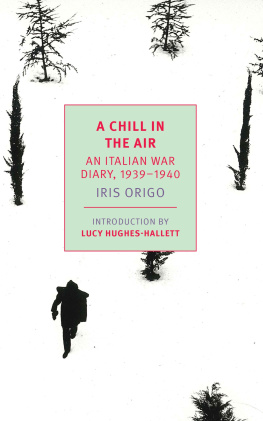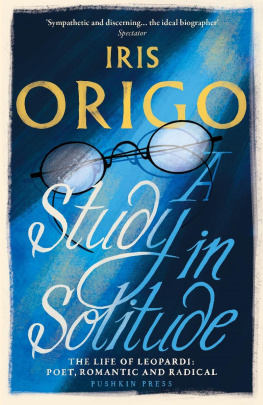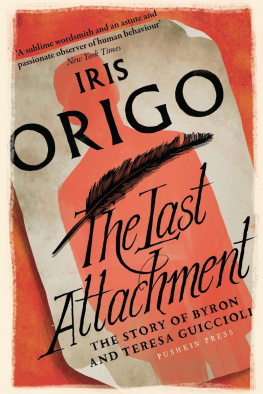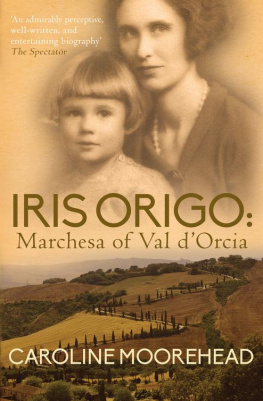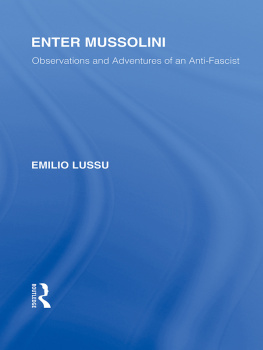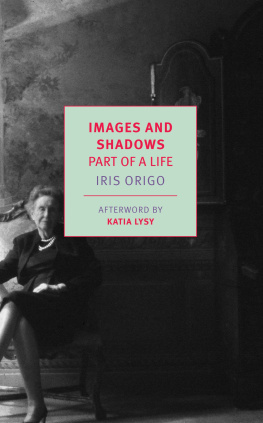
IRIS ORIGO (19021988) was a biographer and writer born in Britain to an aristocrat mother and a wealthy American father. She lived in Italy and devoted much of her life to the improvement of the Tuscan estate at La Foce that she purchased with her husband, Antonio Origo, in the 1920s. Their son, Gianni, died of meningitis in 1933, after which she embarked on a writing career, publishing a successful biography, Leopardi: A Study in Solitude. Traveling in London in the 1930s, she befriended Virginia Woolf and became romantically involved with L. H. Myers (author of he Root and the Flower, available as an NYRB Classic). During World War II, she gave birth to two daughters, Benedetta and Donata, and, together with Antonio, sheltered refugee children and assisted many escaped Allied prisoners of war and partisans in defiance of Italys Fascist regime and Nazi occupation forces. Her memoirs of life in Italy in the war period are collected in two volumes, A Chill in the Air: An Italian War Diary, 19391940 (first published in 2017) and War in Val dOrcia: An Italian War Diary, 19431944 (first published in 1947). In 1976, she was made a Dame Commander of the Order of the British Empire. She died at La Foce.
LUCY HUGHES-HALLETT is a novelist and historian. Her book The Pike: Gabriele DAnnunzio won the Samuel Johnson Prize, the Duff Cooper Prize, and the Costa Biography Award.
KATIA LYSY , a granddaughter of Iris Origo, has worked in publishing and as a journalist and translator. She lives between Rome and southern Tuscany, where she assists her mother, Benedetta, in the management of La Foce.
Afterword
Iris Origos handwriting was famously illegible. When family, friends and publishers despaired of deciphering her letters, manuscripts or notes, the experts would be called in. They included her daughters Benedetta and Donata, her long-suffering secretary and her publisher and close friend Jock Murray, who claimed to have mastered a special technique for reading Iris Origo. He loved to repeat the story of how, on his return to the office after a day in Manchester, he found the entire staff poring over a long letter from Iris. All had been more or less deciphered save the last sentence. He took the letter home with him. The trick, he said, is to have the page at eye level, so I had a bath and a snifter, as Osbert [Lancaster] used to call it, and crept past the table on all fours. It read: Dearest Jock, I cant read what I have written. Please type it out and send a copy to me.
So when a search for family photographs unexpectedly yielded a promising-looking brown box bearing the legend Unpublished in my grandmothers familiar scrawl, I sent up a quick prayer for typewritten material. The brown box turned out to contain many folders of varying dimensions, mostly almost identical versions of standard typewritten pages untidily stapled together, some of them bearing the title Italian Journal, 1940. Unpublished but not unknown to scholars of Iris Origos work, among them her son-in-law Giangiacomo Migone and her biographer Caroline Moorehead. Iris Origo herself quoted these papers in her autobiography Images and Shadows and refers to them in her best-known work, War in Val dOrcia.
Why then was this journal never published? Originally it was not meant to be, I believe, being a very private record in which Iris could give voice to thoughts and feelings she was usually forced to suppress, an occasion to reflect on the extraordinary events to which she was witness and could only discuss with her husband and a handful of friends. Iris was good at keeping her mouth shut and her ears open she knew how to draw people out with a few strategic questions and her keen powers of observation never deserted her, not even when her sentiments were fully engaged and her sense of justice outraged.
Initially she did not intend any part of her diaries to be published. War in Val dOrcia was not meant for the public either, yet was published by Jonathan Cape in 1947, shortly after the end of the conflict. Iris was persuaded to take this step because she strongly believed the rest of the world should hear the other side of the story how ordinary Italians in a remote Tuscan valley suffered the consequences of war and did not hesitate to rescue and shelter their fellow human beings at great personal risk. She must have considered her pre-war journal to be of little interest to others when set against these world-shattering events. Yet in the eighties she showed it to her son-in-law Giangiacomo Migone (husband of her daughter Donata), along with a short piece describing a trip to Libya in 1939 with her husband, Antonio. Migone, who in 1984 founded LIndice dei Libri del Mese, Italys most prestigious literary review to date, immediately recognized the value of both works and encouraged Iris to re-read and set them in order. But as Iriss health declined, she put aside all revision. Almost immediately after her death in June 1988, LIndice dei Libri published her Libyan piece (translated into Italian by Iris herself) on the Italian agricultural settlements established by Mussolini on land confiscated from the Bedouin. The publication of the pre-war journal was put off to a later date, and then never took place.
In my memories, my grandmother Nonna, as her many grandchildren called her has a pen close to hand, usually a leaky ballpoint that left stains on armchairs, chaises-longues and quilted satin counterpanes, which gave away her favourite writing haunts. At La Foce she wrote in her little study on the upper floor, which had much the best view of the Italianate garden, with Pinsents deceptively simple box-hedge geometries laid out at a glance. The delicately painted bookshelves were crammed to overflowing and every surface, even the window-seat cushions in leaf-patterned sea-green and white cretonne, was obscured by stacks of books of all shapes and sizes. There barely seemed to be room on her desk for her typewriter amidst much-thumbed paperbacks, huge dusty tomes, the odd garden catalogue and typewritten sheets of paper covered in a flurry of scribbles, scratched-out words and strips of paper ineptly glued on and curling at the edges. Research was fundamental and Iris would never shirk hours of painstaking labour simply because they yielded only a few extra words. She prided herself on being a historian and her best biographies draw on new material gleaned from archives and unpublished collections of family letters and documents (Leopardi, The Merchant of Prato, The Last Attachment).
As a child, I was encouraged to write for her and presented her regularly with poems and short stories. Despite their obvious shortcomings I cant recall a single word of criticism, only unconditional approval. It was never her way to correct or proffer advice when pressed, if she deemed the authors age adequate to withstand any implied criticism, she would only say: read it through. The more you read it through, the more you will want to leave out. If the price to be paid for all these deletions and afterthoughts was a supremely untidy manuscript, so be it. This being her philosophy, I can well imagine her irritation when her step-father, the literary critic Percy Lubbock, asked to explain the pristine condition of his drafts, said: I think before I write.
Iris was brought to Italy in 1911, at the age of nine, by her English mother, Sybil Cutting. Her American father, Bayard Cutting, who died of tuberculosis when he was only thirty, had expressed the wish that his only child be brought up abroad. But her immensely wealthy American grandparents were opposed to Iriss going far away and a bitter war over who should have the final say in deciding her upbringing and education was waged on both sides of the Atlantic. Finally Sybil, availing herself of her status as sole surviving parent (though a more unmotherly figure is hard to imagine) got her way. Iris grew up in the privileged atmosphere of expatriate Florence and the splendid setting of Villa Medici on the Fiesole hill, where the flower of Tuscan humanists once gathered around Lorenzo the Magnificent. Iris was introduced to the wonders of Renaissance art by their neighbour Bernard Berenson. Edith Wharton, Henry James, Aldous Huxley and Somerset Maugham met in her mothers literary salon, where architects Geoffrey Scott and Cecil Pinsent discussed their designs for Italianate gardens commissioned by Florences foreign community. However, Iris was a lonely little girl, who rarely had a chance to emerge from her ivory tower. Then in 1917 came the Italian armys shattering defeat at Caporetto and an endless stream of refugees. The face of humanity in flight produced an everlasting impression on fifteen-year-old Iris. But apart from these brushes with reality, the young Iris had little chance to mix with Italians and observe the Italian way of life until she met her future husband, an Italian aristocrat called Antonio Origo.

